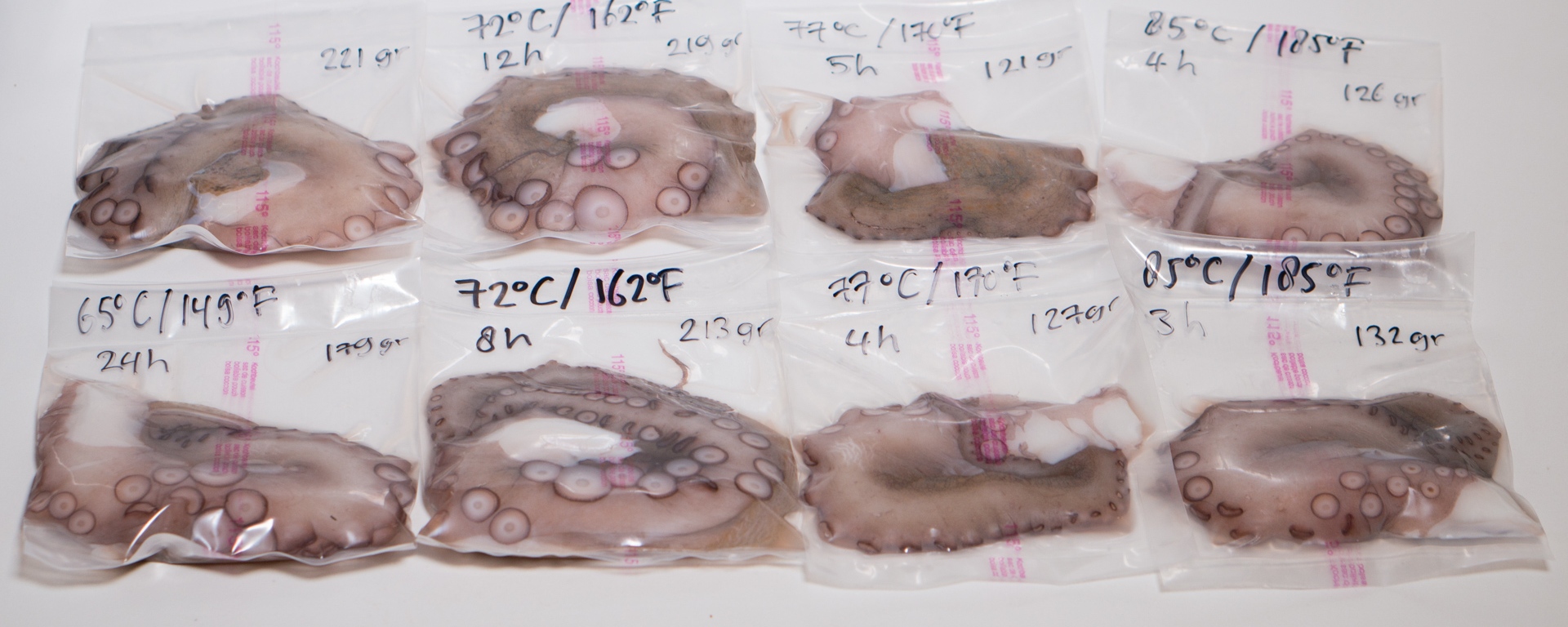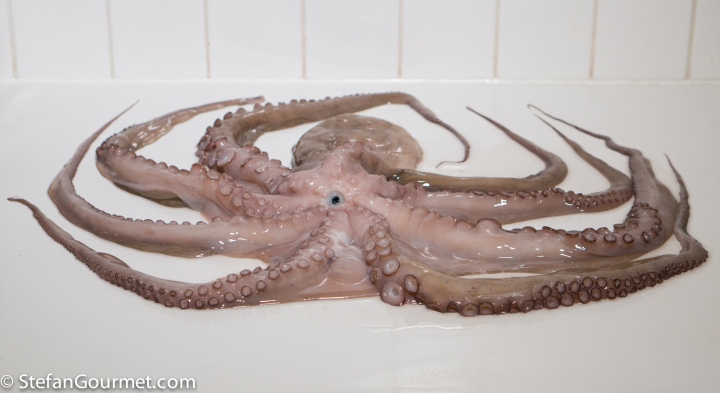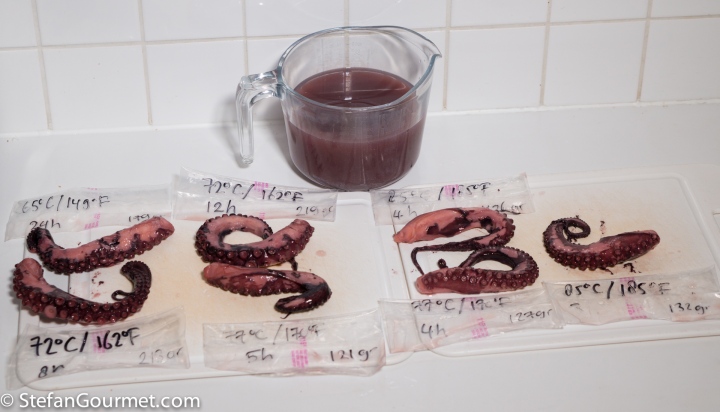Octopus can be tough and tasteless, but when cooked sous-vide more flavor is retained and it will be tender with the right combination of time and temperature. So far I have always used 4 to 5 hours at 77C/170F or 3-4 hours at 85C/185F with good results. But because octopus loses so much liquid when cooking it and because I saw Italians advising 8 hours at 72C/162F, I thought it would be interesting to try lower temperatures. Since an octopus has 8 legs, I tried 8 different combinations of time and temperature.
For this experiment I used the octopus above, which was frozen and after thawing weighed 1.7 kilos (3.7 lbs). Freezing is known to have a tenderizing effect on octopus, so if you use a fresh octopus, you may need to increase the time or temperature. The size also matters: a higher temperature or longer time may be needed for a larger specimen.
I cleaned the octopus and cut it into the 8 legs, head, and ‘connecting part. For the experiment I used only the 8 legs. There was quite a bit of difference between the weight of the legs, with the smallest at 121 grams and the heaviest almost double that at 221 grams. However, I did not notice any pattern in the loss of juices or tenderness that could be attributed to the difference in weight.
I vacuum sealed the legs without adding anything to the bag and I wrote down the weight of each bag.
Initially I cooked only 7, and wanted to decided on the last one based on the results of the others.
I gathered all the liquid to use for a risotto, and weighed and tasted all of the octopus legs. Based on the results I opted to cook the final one for 24 hours at 60C/140F. The results for all 8 time and temperature combinations are shown in the table below.
Findings:
- the differences in tenderness were very small. The tenderness is written down as my subjective judgement of the tenderness on a scale of 1 = very tough to 10 = very tender, with 6 being sufficiently tender but with still quite a bit of bite. All of these were fine and I really had to taste them side by side to tell the difference. This is why I rated them only in the range of 7 to 8 on a scale of 1 to 10.
- the octopus loses a lot of liquid when cooked for all time and temperature combinations, about two thirds of the starting weight. Although the difference in weight indicates that there is some difference, I could not taste that in the juiciness of the octopus. The yield for 3 hours at 85C/185F seems to be an anomaly; I’m not really sure what happened there. In general it seems that a longer time means a slightly higher loss of juices.
- When you decrease the temperature by about 7C/13F, the cooking time roughly doubles to achieve the same tenderness. This can even be extrapolated to boiling the octopus (i.e. cook it at 100C/212F), it will be as tender after 1 hour as it is after 4 hours at 85C/185F.
The main conclusion is that if you adjust the time appropriately, any temperature of 60C/140F or higher will work to cook octopus sous-vide, and the results will be very similar no matter what temperature you pick! So you can pick a time and temperature that is most convenient for you, or perhaps cook the octopus along with something else that requires a specific temperature.
This is a remarkable conclusion that shows that octopus is very different from meat, because for meat the difference between cooking it for example 24 hours at 60C/140F or 3 hours at 85C/185F will be VERY easy to notice!
Some people have reported that octopus cooked sous-vide was tough. If this happens to you when using a time and temperature combination listed above, you could simply increase the time and/or temperature when cooking octopus from the same source the next time around.
(Please note that if you cook the octopus below 60C/140F, you would have to cook it for a very long time and a bad smell can occur. That is why I advise against it. I know because I’ve tried. At 55C/131F the loss of liquid was still similar, so there is no use for it anyway.)








Molto interessante, grazie.
LikeLiked by 1 person
A Sunday debate, Stefan ! Am certain we both were part of such in our high school days and after . . . ! I have read your above experiments more than once . . . kudos for the interest and careful ‘lab’ work. Obviously of interest to you. Now, I happen to love octopus . . . the baby ones usually end up in my oft-times prepared stirfries, the lovely big ones are most often cooked Mediterranean-style, bathed in tomato and onion subjected to a variety of herbs and a few spices. Cooked, with the most beautiful aromas rising stovetop, for as long as it takes. No temperature gauges, no exact timing. Have yet to put a less than enjoyable dish along some salad and perchance a noble grain on the table. I respect and admire your interest and your exactness and the correctness of your results . . . . just wonder how I am just as pleased with mine, having used the extra available time for so many matters always awaiting my time limits . . . . *huge smile* . . .Just wondering about each precious minute of the day . . . a debate, as I said . . .
LikeLike
Hi Eha, if you are going to have the octopus with the sauce (tomatoes etc.) then I would also cook it on the stove. But the traditional method takes considerably more hands-on time than cooking it sous-vide because the pot needs to be tended, while sous vide would not require any attending and actually would take only 2 minutes of hands-on time and freedom to do whatever while the octopus is cooking. The sous-vide method is most suited for octopus that is going to be served Italian style, cold with olive oil, parsley and a drop of lemon juice, because more of the flavor will be preserved inside the octopus. With a sauce it is fine that the flavor ends up in the sauce. If this post demonstrates anything, is that exact timing is not at all important when cooking octopus sous-vide, as the results for 3 or 4 hours were so similar.
LikeLiked by 1 person
Thank you for having taken the time to respond to an ‘obstreperous child’ ! I promise to be ‘good’ next time you publish ‘sous-vide’ !! I am a typical Gemini – I can and do think in two opposite ways . . . methinks the main ‘problem’ reading your and Conor’s etc posts is that I still have to be convinced of the efficacy of sous-vide cooking 🙂 ! Methinks we are allowed our differences !!! With glorious fresh ingredients I am very hands-on preparing them for the delights of consumption . . . with the amount of food TV watching going on in this house I am not ignorant . . .as a med school graduate I just do not envisage my dinner ‘bathed’ in warm water at exactly the right temperature ‘for ever and ever’ only to have to be ‘coloured’ in a pan after . . . over and out with a big hug . . .
LikeLiked by 1 person
A classic Stefan post. The main advantage of SV octopus seems to be twofold. Hands off time and timing flexibility both stand out for me. Great job.
LikeLiked by 1 person
You are a very detailed and precise person, thank you for taking the time to experiment with the octopus. I ate quite a few of these delicacies while in Spain, but they were mostly grilled.
Slightly off topic, I recently made an Asian-inspired steamed fish that I think would be perfect for sous-vide (and I think you’ll love it too). I will be posting the recipe next time I cook it, as I didn’t take photos.
LikeLiked by 1 person
Looking forward to that!
LikeLike
As far as I know, all grilled octopus (at least the grilled octopus cooked in spain) has been previously boiled 🙂
LikeLiked by 1 person
Very interesting article exploring possible time x temperature combinations. Can you please expand on the statement about doubling cooking time when decreasing temperature. I’ve seen different temperature decrease values but nowhere have I found a categoric description of the method/theory. In my experience different temperature-time combinations are perfectly possible with completely different textures (e.g. short ribs, oxtail). I’d love to get some specific information on the 7C/13F temperature decrease versus time doubling.
LikeLike
Hi Fabio,
The 7C/13F temperature decrease and time doubling only applies to octopus. The main finding of my experiment is that for octopus, unlike meat like short ribs or oxtail, you do NOT get a different texture if you change the temperature, as long as you adjust the time appropriately. For short ribs or oxtail that is definitely not true. For all meat including short ribs and oxtail, you can get a GOOD result at different temperatures when you adjust the time appropriately, but the texture will be VERY different. This is because octopus has a different protein structure, but I don’t have a full theoretic explanation of this. Does this help?
Regards,
Stefan
LikeLike
Kuddos for your post.
I always admire your detailed and meticulous work. As well as I envy the amount of good restaurants you try 🙂
Your bog and post in SV groups are one of my go-to ones when I want to assure a good result , and learn something in the process.
Last, but not least, as a Spanish who had eaten tons of Pulpo a feira in Galicia (where the best Octopus are find …if you allow me), I do prefer the SV method for its reliability.
LikeLiked by 1 person
Kuddos for your post.
I always admire your detailed and meticulous work. As well as I envy the amount of good restaurants you try 🙂
Your bog and post in SV groups are one of my go-to ones when I want to assure a good result , and learn something in the process.
Last, but not least, as a Spanish who had eaten tons of Pulpo a feira in Galicia (where the best Octopus are find …if you allow me), I do prefer the SV method for its reliability.
LikeLike